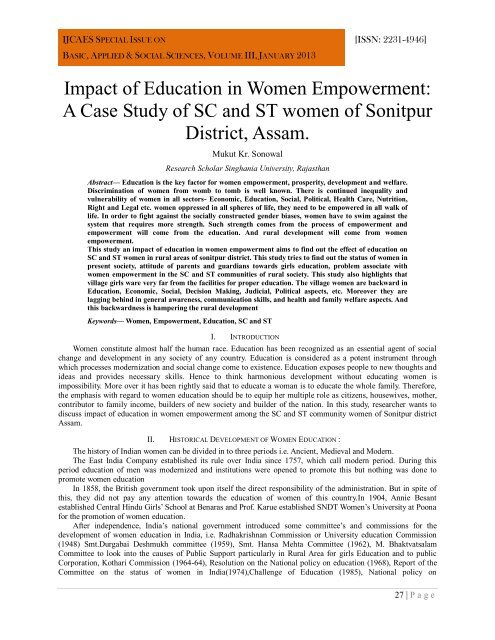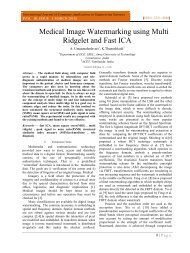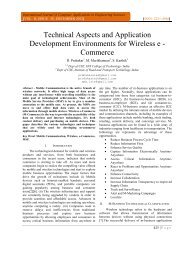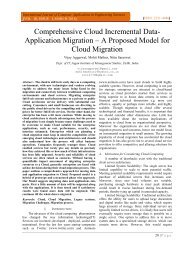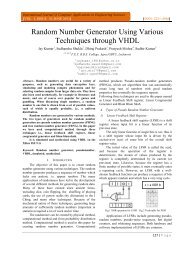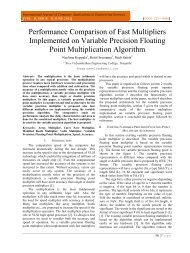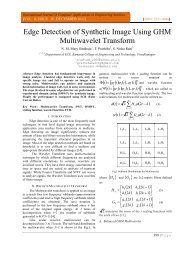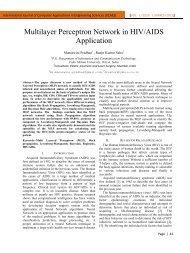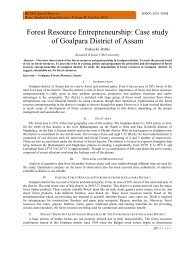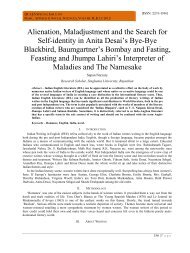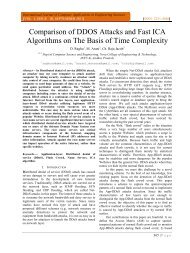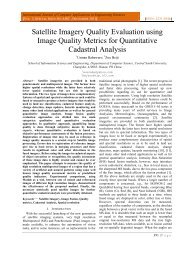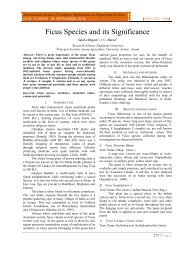Impact of Education in Women Empowerment: A Case Study of SC ...
Impact of Education in Women Empowerment: A Case Study of SC ...
Impact of Education in Women Empowerment: A Case Study of SC ...
You also want an ePaper? Increase the reach of your titles
YUMPU automatically turns print PDFs into web optimized ePapers that Google loves.
IJCAES SPECIAL ISSUE ON<br />
BASIC, APPLIED & SOCIAL <strong>SC</strong>IENCES, VOLUME III, JANUARY 2013<br />
[ISSN: 2231-4946]<br />
<strong>Impact</strong> <strong>of</strong> <strong>Education</strong> <strong>in</strong> <strong>Women</strong> <strong>Empowerment</strong>:<br />
A <strong>Case</strong> <strong>Study</strong> <strong>of</strong> <strong>SC</strong> and ST women <strong>of</strong> Sonitpur<br />
District, Assam.<br />
Mukut Kr. Sonowal<br />
Research Scholar S<strong>in</strong>ghania University, Rajasthan<br />
Abstract— <strong>Education</strong> is the key factor for women empowerment, prosperity, development and welfare.<br />
Discrim<strong>in</strong>ation <strong>of</strong> women from womb to tomb is well known. There is cont<strong>in</strong>ued <strong>in</strong>equality and<br />
vulnerability <strong>of</strong> women <strong>in</strong> all sectors- Economic, <strong>Education</strong>, Social, Political, Health Care, Nutrition,<br />
Right and Legal etc. women oppressed <strong>in</strong> all spheres <strong>of</strong> life, they need to be empowered <strong>in</strong> all walk <strong>of</strong><br />
life. In order to fight aga<strong>in</strong>st the socially constructed gender biases, women have to swim aga<strong>in</strong>st the<br />
system that requires more strength. Such strength comes from the process <strong>of</strong> empowerment and<br />
empowerment will come from the education. And rural development will come from women<br />
empowerment.<br />
This study an impact <strong>of</strong> education <strong>in</strong> women empowerment aims to f<strong>in</strong>d out the effect <strong>of</strong> education on<br />
<strong>SC</strong> and ST women <strong>in</strong> rural areas <strong>of</strong> sonitpur district. This study tries to f<strong>in</strong>d out the status <strong>of</strong> women <strong>in</strong><br />
present society, attitude <strong>of</strong> parents and guardians towards girls education, problem associate with<br />
women empowerment <strong>in</strong> the <strong>SC</strong> and ST communities <strong>of</strong> rural society. This study also highlights that<br />
village girls ware very far from the facilities for proper education. The village women are backward <strong>in</strong><br />
<strong>Education</strong>, Economic, Social, Decision Mak<strong>in</strong>g, Judicial, Political aspects, etc. Moreover they are<br />
lagg<strong>in</strong>g beh<strong>in</strong>d <strong>in</strong> general awareness, communication skills, and health and family welfare aspects. And<br />
this backwardness is hamper<strong>in</strong>g the rural development<br />
Keywords— <strong>Women</strong>, <strong>Empowerment</strong>, <strong>Education</strong>, <strong>SC</strong> and ST<br />
I. INTRODUCTION<br />
<strong>Women</strong> constitute almost half the human race. <strong>Education</strong> has been recognized as an essential agent <strong>of</strong> social<br />
change and development <strong>in</strong> any society <strong>of</strong> any country. <strong>Education</strong> is considered as a potent <strong>in</strong>strument through<br />
which processes modernization and social change come to existence. <strong>Education</strong> exposes people to new thoughts and<br />
ideas and provides necessary skills. Hence to th<strong>in</strong>k harmonious development without educat<strong>in</strong>g women is<br />
impossibility. More over it has been rightly said that to educate a woman is to educate the whole family. Therefore,<br />
the emphasis with regard to women education should be to equip her multiple role as citizens, housewives, mother,<br />
contributor to family <strong>in</strong>come, builders <strong>of</strong> new society and builder <strong>of</strong> the nation. In this study, researcher wants to<br />
discuss impact <strong>of</strong> education <strong>in</strong> women empowerment among the <strong>SC</strong> and ST community women <strong>of</strong> Sonitpur district<br />
Assam.<br />
II. HISTORICAL DEVELOPMENT OF WOMEN EDUCATION :<br />
The history <strong>of</strong> Indian women can be divided <strong>in</strong> to three periods i.e. Ancient, Medieval and Modern.<br />
The East India Company established its rule over India s<strong>in</strong>ce 1757, which call modern period. Dur<strong>in</strong>g this<br />
period education <strong>of</strong> men was modernized and <strong>in</strong>stitutions were opened to promote this but noth<strong>in</strong>g was done to<br />
promote women education<br />
In 1858, the British government took upon itself the direct responsibility <strong>of</strong> the adm<strong>in</strong>istration. But <strong>in</strong> spite <strong>of</strong><br />
this, they did not pay any attention towards the education <strong>of</strong> women <strong>of</strong> this country.In 1904, Annie Besant<br />
established Central H<strong>in</strong>du Girls‟ School at Benaras and Pr<strong>of</strong>. Karue established SNDT <strong>Women</strong>‟s University at Poona<br />
for the promotion <strong>of</strong> women education.<br />
After <strong>in</strong>dependence, India‟s national government <strong>in</strong>troduced some committee‟s and commissions for the<br />
development <strong>of</strong> women education <strong>in</strong> India, i.e. Radhakrishnan Commission or University education Commission<br />
(1948) Smt.Durgabai Deshmukh committee (1959), Smt. Hansa Mehta Committee (1962), M. Bhaktvatsalam<br />
Committee to look <strong>in</strong>to the causes <strong>of</strong> Public Support particularly <strong>in</strong> Rural Area for girls <strong>Education</strong> and to public<br />
Corporation, Kothari Commission (1964-64), Resolution on the National policy on education (1968), Report <strong>of</strong> the<br />
Committee on the status <strong>of</strong> women <strong>in</strong> India(1974),Challenge <strong>of</strong> <strong>Education</strong> (1985), National policy on<br />
27 | P a g e
Mukut Kr. Sonowal<br />
<strong>Education</strong>(1986), Programme <strong>of</strong> Action(1986), and (1992),etc. On the other hand, to develop the primary education<br />
and to achieve the aim <strong>of</strong> universalisation <strong>of</strong> primary education upto age level 6-14 years, some schemes or<br />
programmes like, OBB, DPEP, SSA, NLM, National Programme <strong>of</strong> Nutritional Support <strong>of</strong> Primary <strong>Education</strong><br />
(NPNSPE) or(Mid-Day Meals),RTE Act 2009 and Knowledge Commission etc. were <strong>in</strong>troduced to achieve the<br />
national goal i.e. hundred percent literacy. Despite these government efforts to the education, still women are<br />
lagg<strong>in</strong>g beh<strong>in</strong>d than men. <strong>Women</strong> <strong>of</strong> India generally rema<strong>in</strong>ed unlettered and uneducated. As a result <strong>of</strong> ignorance,<br />
women become victims <strong>of</strong> man dom<strong>in</strong>ated society.<br />
28 | P a g e<br />
III. STATUS OF WOMEN IN ASSAMESE SOCIETY :<br />
Assam is situated <strong>in</strong> the North Eastern region <strong>of</strong> India. It has a glorious past with rich culture, society <strong>in</strong> northeast<br />
India and as such <strong>in</strong> Assam. Assamese women possessed great freedom <strong>of</strong> work and movement <strong>in</strong> the past time.<br />
<strong>Education</strong> was limited to the high caste and equivalent castes only. There were no provisions <strong>of</strong> education for lower<br />
caste women. <strong>Women</strong> slaves were called Bandis or Betis. The women are an <strong>in</strong>tegral part <strong>in</strong> every society. But status<br />
and education <strong>of</strong> a women <strong>in</strong> Assamese society are still backward than men. On the other hand women <strong>of</strong> <strong>SC</strong> and ST<br />
communities are most backward than others.<br />
The Indian constitution has granted equal right and status to all irrespective <strong>of</strong> caste, creed and gender. But <strong>in</strong><br />
practice women have been deprived <strong>of</strong> their constitutional rights <strong>in</strong> various ways. They are becom<strong>in</strong>g victims <strong>of</strong><br />
various social <strong>in</strong>justice and they are not be<strong>in</strong>g able to enjoy their due right and status <strong>in</strong> society.<br />
IV. A PROFILE OF SONITPUR DISTRICT :<br />
The Sonitpur district is one <strong>of</strong> the districts <strong>of</strong> Assam. It is situated between the Brahmaputra River on the south<br />
and the foothills <strong>of</strong> Eastern Himalayas form<strong>in</strong>g part <strong>of</strong> Bhutan, Kameng district <strong>of</strong> Arunachal Pradesh on the north.<br />
Lakhimpur district is situated to the eastern part and Udalguri district is situated to the western part. Accord<strong>in</strong>g to the<br />
census report <strong>of</strong> 2011, the district covered a total area <strong>of</strong> 5,324 sq. km. And total population <strong>of</strong> 1,925,975 <strong>of</strong> which<br />
989,919 were male and 936,056were females. The literacy rate <strong>of</strong> the district is 69.96, out <strong>of</strong> which the male literacy<br />
rate is 76.98 and that for the female is 62.53.<br />
The Sonitpur district has fertile river valley, rich water streams, Bills, Tanks etc. There are many reserved<br />
forests such as Naduar, Nameri Tiger Reserve Forest Pabhoi Reserve Forest, Behali reserve Forest etc. Tea, paddy,<br />
vegetables, sugarcane, jute are the ma<strong>in</strong> agricultural products <strong>of</strong> Sonitpur district. Bodo,Mis<strong>in</strong>g, Nepali, Bengali,<br />
Muslims, etc. are the good farmers <strong>of</strong> this district. They produce various types <strong>of</strong> vegetables <strong>in</strong> heavy quantity <strong>in</strong> the<br />
Char areas (river bank). Sonitpur district is dom<strong>in</strong>ated by Char, Tea belts and forest village area. Different deprived<br />
communities like Bodo, Mis<strong>in</strong>g, Kaibatra(fish<strong>in</strong>g pr<strong>of</strong>esioner), etc. are liv<strong>in</strong>g <strong>in</strong> these Char (river bank) and forest<br />
village areas <strong>in</strong> very poor condition without hav<strong>in</strong>g good education and modern facilities <strong>of</strong> their life.<br />
The literacy rate <strong>of</strong> Sonitpur district is not satisfactory. The overall literacy rate <strong>in</strong> the year 2011 is 69.96 where<br />
male was 76.98 female was 62.53 percent. It was 59.07 <strong>in</strong> the year 2001 and 48.14 <strong>in</strong> the year 1991 <strong>in</strong> person. The<br />
lagg<strong>in</strong>g factors <strong>in</strong> Sonitpur district are related to the conditions prevail<strong>in</strong>g <strong>in</strong> the Char areas, forest villages where<br />
arrangements <strong>of</strong> education <strong>of</strong> the poorer section <strong>of</strong> the people still not adequate.The purpose <strong>of</strong> this study is to know<br />
the impact <strong>of</strong> education <strong>in</strong> women empowerment <strong>in</strong> the <strong>SC</strong> and ST Community <strong>of</strong> Sonitpur district <strong>of</strong> Assam.<br />
Significance <strong>of</strong> women <strong>Empowerment</strong> :<strong>Women</strong> are nearly half <strong>of</strong> the human capital <strong>in</strong> the society. They also<br />
play varied role <strong>in</strong> the society. Progress and development is human centered process. Without women equal<br />
evolvement development process at every level will be <strong>in</strong>adequate. Swami Vivekananda said that “there is no chance<br />
for the welfare <strong>of</strong> the world unless condition <strong>of</strong> women is improved. It is not possible for a bird to fly only with one<br />
w<strong>in</strong>g.” Human Resource Development applies equality to women and men.<br />
<strong>Education</strong> is an important for everyone, but it is especially significant for girls and women. The educational<br />
achievement <strong>of</strong> women can have ripple effect with<strong>in</strong> the family and across generation.<br />
“<strong>Education</strong> <strong>of</strong> boy is education <strong>of</strong> one person, but education <strong>of</strong> a girl is the education <strong>of</strong> the entire family”, said<br />
Jawaharlal Nehru while underly<strong>in</strong>g the importance <strong>of</strong> women education.<br />
The women <strong>of</strong> any country have an important contribution <strong>in</strong> the progress <strong>of</strong> that country. It is the women who<br />
are capable <strong>of</strong> build<strong>in</strong>g such children who may lead the country to the path <strong>of</strong> progress and prosperity. Educated<br />
women make the family and the society cultured.<br />
<strong>Education</strong> is the key factor for women empowerment, prosperity, development and welfare. Discrim<strong>in</strong>ation <strong>of</strong><br />
women from womb to tomb is well-known. There is cont<strong>in</strong>ued <strong>in</strong>equality and vulnerability <strong>of</strong> women <strong>in</strong> all sectors –<br />
economic, social, political, education, health-care, nutrition, right and legal etc. <strong>Women</strong> oppressed <strong>in</strong> all spheres <strong>of</strong><br />
life, they need to be empowered <strong>in</strong> all walk <strong>of</strong> life. In order to fight aga<strong>in</strong>st the socially constructed gender biases,<br />
women have to swim aga<strong>in</strong>st the system that requires more strength. Such strength comes from the process <strong>of</strong><br />
empowerment and empowerment will come from the education.
<strong>Impact</strong> <strong>of</strong> <strong>Education</strong> <strong>in</strong> <strong>Women</strong> <strong>Empowerment</strong>: A <strong>Case</strong> <strong>Study</strong> <strong>of</strong> <strong>SC</strong> and ST women <strong>of</strong> Sonitpur District, Assam<br />
Thus, when talk <strong>of</strong> women‟s development and women‟s status, it is important for us to recognize that<br />
<strong>in</strong>terventions at all levels namely social, cultural, economic, education, health and family welfare, politics, etc. are<br />
required and are possible only if changes take place <strong>in</strong> the exist<strong>in</strong>g system and social structures, which are not at all<br />
favorable to the women today.<br />
<strong>Education</strong> is one <strong>of</strong> the most important means <strong>of</strong> empower<strong>in</strong>g women and giv<strong>in</strong>g them knowledge, skills and<br />
self confidence necessary to be full partner <strong>in</strong> the development process.<br />
V. OBJECTIVE OF THE STUDY :<br />
‣ To study the effect <strong>of</strong> education <strong>in</strong> women empowerment.<br />
‣ To study the impact <strong>of</strong> education <strong>in</strong> rural areas <strong>of</strong> Sonitpur district.<br />
‣ To study the impact <strong>of</strong> education <strong>in</strong> the women <strong>of</strong> <strong>SC</strong> and ST community <strong>of</strong> Sonitpur district.<br />
‣ To study the causes and factors <strong>of</strong> backwardness <strong>in</strong> education.<br />
‣ To study the other factors related to <strong>SC</strong> and ST women and development.<br />
VI. HYPOTHESIS OF THE STUDY :<br />
‣ The effect <strong>of</strong> modern education <strong>in</strong> women empowerment is not satisfactory.<br />
‣ <strong>Impact</strong> <strong>of</strong> modern education is yet to reach the corners <strong>of</strong> villages.<br />
‣ <strong>Women</strong> <strong>of</strong> <strong>SC</strong> and ST community are most backward as compared to women <strong>of</strong> general community <strong>in</strong><br />
education.<br />
‣ The communication and other accommodation facilities are not equally and properly distributed <strong>in</strong> different<br />
places <strong>of</strong> Sonitpur district.<br />
‣ The effect <strong>of</strong> education <strong>in</strong> <strong>SC</strong> and ST women and rural development is not satisfactory.<br />
VII. DEFINITION OF KEY TERMS<br />
‣ <strong>Impact</strong> :Accord<strong>in</strong>g to the Chamber‟s 21 st Century Dictionary, the word “<strong>Impact</strong>” means “Effect” and<br />
“Influence”. Accord<strong>in</strong>g to the Oxford Dictionary, the mean<strong>in</strong>g <strong>of</strong> “<strong>Impact</strong>” is “Immediate effect‟ or<br />
“Influence”. In this study the word “impact” means „Effect” or “Influence”.<br />
‣ <strong>Education</strong> : Accord<strong>in</strong>g to the Oxford Dictionary and Thesaures, the word “<strong>Education</strong>” means br<strong>in</strong>g up,<br />
civilized, cultivate, tra<strong>in</strong><strong>in</strong>g, teach<strong>in</strong>g, guidance, school<strong>in</strong>g etc.<br />
‣ Accord<strong>in</strong>g to the Dictionary <strong>of</strong> <strong>Education</strong> the word “<strong>Education</strong>” means (i) It <strong>in</strong>cludes all the process that<br />
develop human ability and behaviour. (ii) The aggregate <strong>of</strong> all the process by which a person develops<br />
abilities, attitudes and other forms <strong>of</strong> behaviour, positive value <strong>in</strong> the society <strong>in</strong> which he or she lives.<br />
‣ <strong>Empowerment</strong> :Accord<strong>in</strong>g to the Oxford Dictionary and Thesaurus the word “<strong>Empowerment</strong>” means “give<br />
power” or “Authorize” or “license”.<br />
‣ Accord<strong>in</strong>g to the Cambridge International Dictionary, the “<strong>Empowerment</strong>” means to give (some one) the<br />
<strong>of</strong>ficial legal authority or freedom to do someth<strong>in</strong>g.<br />
‣ Development :Accord<strong>in</strong>g to Oxford Dictionary and thesaurus the word “Development” means “stage <strong>of</strong><br />
growth” or “advancement” or “extension” or “improvement”.<br />
In this study the word “<strong>Impact</strong>” means “Effect” or “Influence” and the word “Modern” means “Most recent” or<br />
“Present”. It means the effect <strong>of</strong> most recent education system <strong>of</strong> the state on women empowerment and rural<br />
development.<br />
VIII.<br />
LIMITATION OF THE STUDY<br />
Follow<strong>in</strong>g are the ma<strong>in</strong> limitations <strong>of</strong> this research work –<br />
‣ Due to the vastness <strong>of</strong> the topic, it is not possible to cover all the aspect with<strong>in</strong> a limited period. Therefore, the<br />
study is strictly conducted only with<strong>in</strong> the sonitpur district <strong>of</strong> Assam.<br />
‣ The study is restricted with<strong>in</strong> educated and uneducated section <strong>of</strong> <strong>SC</strong> and ST women and work<strong>in</strong>g and nonwork<strong>in</strong>g<br />
classes <strong>of</strong> women <strong>in</strong> sonitpur district.<br />
‣ The study will cover only the <strong>SC</strong>, ST Community women from the sonitpur district.<br />
‣ The study will cover only rural area <strong>of</strong> the sonitpur district.<br />
IX.<br />
RESEARCH DESIGN<br />
As the present study tries to f<strong>in</strong>d out the impact <strong>of</strong> modern education <strong>in</strong> the <strong>Women</strong> <strong>of</strong> rural areas and compare<br />
the woman <strong>of</strong> general and <strong>SC</strong> and ST Communities <strong>of</strong> Sonitpur district, it falls under the descriptive survey<br />
29 | P a g e
Mukut Kr. Sonowal<br />
Category <strong>of</strong> education research. This study will also focus <strong>in</strong> the facilities provided for women empowerment and<br />
rural development <strong>in</strong> different parts <strong>of</strong> Sonitpur district.<br />
Data were collected from both primary and secondary sources. A questionnaire <strong>of</strong> 40 <strong>in</strong>quiries were presented<br />
by <strong>in</strong>vestigator and presented to the age group 18-40 years women <strong>of</strong> different families Of Sonitpur district. Here<br />
two villages each from Tezpur, Biswanath and Gohpur Sub-division eight respondents was selected for survey and<br />
total <strong>of</strong> 40 respondents answered the <strong>in</strong>quiries. Out <strong>of</strong> total 40 women respondents 20 were belongs to <strong>SC</strong> and 20<br />
respondents belong to ST category. Data were analyzed by the percentage <strong>of</strong> respondents.<br />
X. MAJOR FINDINGS<br />
A. <strong>Education</strong>al Backwardness<br />
It has been found while analyz<strong>in</strong>g the data that <strong>SC</strong> and ST village women <strong>of</strong> sonitpur district are lagg<strong>in</strong>g beh<strong>in</strong>d<br />
<strong>in</strong> compression to state literacy rate. The study shows that out <strong>of</strong> 40 respondents 52.5 % are illiterate, 22.5 % are<br />
school educated or undermatric, 17.5 % are matriculates, 5 % are <strong>in</strong>termediates and 2.5 % are graduates. There are<br />
no s<strong>in</strong>gle PG holder and pr<strong>of</strong>essional women <strong>in</strong> the <strong>SC</strong> and ST village area. This study shows that village woman <strong>of</strong><br />
sonitpur district are still much backward <strong>in</strong> education then 67.27 % women literacy rate state <strong>of</strong> Assam (census<br />
report 2011). Where there 55 % ST and 50 % <strong>SC</strong> communities women are still illittered. The study shows that 77.5<br />
% women were believe that 3R is not sufficient education for women and 95 % respondent answered the <strong>in</strong>quiries<br />
that there are no night school, adult school, part time school and any other special education <strong>in</strong> their area for women<br />
education.<br />
Academi<br />
c<br />
Standard<br />
No.<strong>of</strong><br />
responde<br />
nt<br />
Percenta<br />
ge<br />
(%)<br />
Illiterate<br />
<strong>SC</strong>=<br />
10<br />
ST=<br />
11<br />
50<br />
%<br />
55<br />
%<br />
TABLE – 1 : EDUCATIONAL STANDARDS OF THE RURAL WOMEN.<br />
School Edn.<br />
(i-ix)<br />
Matric- ulation<br />
(x pass)<br />
<strong>SC</strong>=4 20% <strong>SC</strong>=4 20%<br />
ST=5 25% ST=3 15%<br />
HS<br />
(xii pass)<br />
<strong>SC</strong><br />
=1<br />
ST<br />
=1<br />
Graduate<br />
5% <strong>SC</strong>=1<br />
5% ST=0 -<br />
5<br />
%<br />
PG<br />
holder<br />
Pr<strong>of</strong>essional<br />
Oth<br />
er<br />
Nil Nil Nil<br />
52.5 % 22.5 % 17.5% 5 % 2.5 % - - -<br />
The study, exposes 80 % village girl have not received separate read<strong>in</strong>g room at home, 52.5 % girl were not<br />
received the proper study materials and stationeries which are needed for faire study, 97.5 % girls have to engage <strong>in</strong><br />
house hold duties. In this study, it has been found that 92.5 % girls were not received proper education due to<br />
f<strong>in</strong>ancial crises and 80 % were due to house hold works and tak<strong>in</strong>g care <strong>of</strong> brothers and sisters.<br />
TABLE – 2 : EDUCATIONAL FACILITIES FOR GIRLS.<br />
Provid<strong>in</strong>g Facilities<br />
Received<br />
Not-Received<br />
Respondent Percentage Respondent Percentage<br />
1.Provid<strong>in</strong>g separate read<strong>in</strong>g room <strong>SC</strong>=8 ST=0 20% 32 80 %<br />
2.Mak<strong>in</strong>g arrangement necessary books and<br />
journal<br />
<strong>SC</strong>=7 ST=12 47.5 % 21 52.5 %<br />
3.Reliv<strong>in</strong>g and house hold activities <strong>SC</strong>=1 ST=0 2.5 % 39 97.5 %<br />
4.Support<strong>in</strong>g to stay <strong>in</strong> hostel, board<strong>in</strong>g<br />
house etc.<br />
Nil - Nil -<br />
30 | P a g e
<strong>Impact</strong> <strong>of</strong> <strong>Education</strong> <strong>in</strong> <strong>Women</strong> <strong>Empowerment</strong>: A <strong>Case</strong> <strong>Study</strong> <strong>of</strong> <strong>SC</strong> and ST women <strong>of</strong> Sonitpur District, Assam<br />
5.By any other means <strong>SC</strong>=9 St=12 52.5 % 19 47.5 %<br />
B. Occupational Backwardness:<br />
In this study, it has been found that 85 % village women are housewives, 12.5 % women are wage earner and<br />
2.5 % women were work<strong>in</strong>g <strong>in</strong> different govt. semi govt. and private sectors. There are no s<strong>in</strong>gle pr<strong>of</strong>essionals and<br />
bus<strong>in</strong>ess women <strong>in</strong> the village area.<br />
TABLE – 3: RESPONDENTS OCCUPATION.<br />
Service Pr<strong>of</strong>essional Bus<strong>in</strong>ess Housewife Cultivation Wage earner Other Total<br />
1 (2.5 %) 0 (-) 0 (-) 34 (85 %) 0 (-) 5 (12.5 %) 0 (-) 40<br />
C. Economic Backwardness:<br />
Most <strong>of</strong> the village women are poorer and they live under the billow poverty l<strong>in</strong>e. In this study, 73.33 % women<br />
<strong>in</strong> the village area come from the BPL families. There are no s<strong>in</strong>gle respondent above group 1,00,000 <strong>in</strong> village area.<br />
There for women from the village area are not able to bear the expensive expenditure <strong>of</strong> education, health care and<br />
family welfare, nutrition, co-curricular activities, uses <strong>of</strong> mass media etc. out <strong>of</strong> total 40 <strong>of</strong> our respondents only 7.5<br />
% women liv<strong>in</strong>g <strong>in</strong> rural area plan their family budget and 92.5 % depend on their husband and guardian.<br />
TABLE – 4: ECONOMIC STATUS OF FAMILY.<br />
Group No. <strong>of</strong> family Percentage (%)<br />
Below 21,000 <strong>SC</strong>=10, ST=12= 22 55 %<br />
21,001 – 50,000 <strong>SC</strong>=7, ST=6= 13 32.5 %<br />
50,001 – 1,00,000 <strong>SC</strong>=3, ST=2= 5 12.5 %<br />
Above 1,00,000 Nil Nil<br />
D. Social Backwardness:<br />
<strong>Women</strong> <strong>of</strong> <strong>SC</strong> and ST communities are liv<strong>in</strong>g <strong>in</strong> rural area socially backward with comparison to the general<br />
community‟s women. Preajudies, Super Stitions, Da<strong>in</strong>i, Tantra-Mantra, Bhoot etc. are more among the rural area<br />
people as compared to the town area. In this study we found that 95 % women <strong>of</strong> <strong>SC</strong> and ST have taken treatment<br />
from Bez or Kabiraj (quacks) <strong>in</strong>stead <strong>of</strong> Doctors advice, superstitious believes are still exists among different<br />
communities like Bodos, Rabhas, Mis<strong>in</strong>gs, Adibashis etc. 75% women and girls are still fac<strong>in</strong>g restriction from their<br />
parents to travel any place and any where. 95 % women were feel<strong>in</strong>g <strong>in</strong>secure to travel anywhere due to lake <strong>of</strong><br />
knowledge and empowerment. <strong>Women</strong> are still dom<strong>in</strong>ated by their husband and other male member <strong>of</strong> paternal<br />
society. On the other hand out <strong>of</strong> 40 respondent 12.5 % women were <strong>in</strong> favour <strong>of</strong> separate school for girls.<br />
E. Political backwardness:<br />
<strong>Women</strong> <strong>of</strong> village <strong>in</strong> general and <strong>SC</strong>, ST communities <strong>in</strong> particular are very backward <strong>in</strong> political aspects. Out<br />
<strong>of</strong> 40 respondents 30 % <strong>SC</strong> and 40 % ST responded that they have not participated <strong>in</strong> the election process <strong>of</strong><br />
Panchayat, Assembly and Parliament. In this study it‟s also found that only 7.5 % women are active member <strong>of</strong><br />
political parties. On the other hand 92.5 % women <strong>of</strong> village area never tried to solve their local problem through the<br />
MLA, Society, DC, BDO, President Gaon Panchayat, Ward Member, Head <strong>of</strong> Village, NGO and club.<br />
F. Backwardness <strong>in</strong> decision mak<strong>in</strong>g process:<br />
In this study, it has been found that 37.5 % women liv<strong>in</strong>g <strong>in</strong> the rural area are active member <strong>of</strong> self help group,<br />
4o % women member <strong>of</strong> SHG related to deposit money for loan scheme, 20 % women member <strong>of</strong> SHG related to<br />
Weav<strong>in</strong>g, Cutt<strong>in</strong>g and Knitt<strong>in</strong>g, 15 % women were related to animal husbandry and only 5 % women were related to<br />
grocery and retaliat<strong>in</strong>g. Out <strong>of</strong> total 40 <strong>of</strong> our respondents only 7.5 % women <strong>of</strong> rural area plan their family budget<br />
and 92.5 % depend on their husband and guardian, 22.5 % women <strong>of</strong> rural area sometimes purchases their daily<br />
used essential commodities and 77.5 % women depend on their husband and guardian. On the other hand 45 %<br />
women were <strong>of</strong>ten, 55 % were sometimes participate <strong>in</strong> all the decision mak<strong>in</strong>g process <strong>of</strong> their family. There are no<br />
s<strong>in</strong>gle respondent actively <strong>in</strong>volved <strong>in</strong> all the decision mak<strong>in</strong>g process.<br />
31 | P a g e
Mukut Kr. Sonowal<br />
G. Right and Judicial Backwardness<br />
In this study, it has been found that out <strong>of</strong> 40 respondents 35 i.e. 87.5 % women <strong>of</strong> <strong>SC</strong>, ST communities liv<strong>in</strong>g<br />
<strong>in</strong> rural area are not aware <strong>of</strong> their constitutional right and legal facilities and safeguards <strong>of</strong> equal opportunities to<br />
women. In this study it is found that 90 % <strong>SC</strong> and ST women liv<strong>in</strong>g <strong>in</strong> rural area do not know constitutional<br />
provision <strong>of</strong> reservation for women and other facilities provided by the Indian constitution, 92.5 % women <strong>of</strong> <strong>SC</strong><br />
and ST liv<strong>in</strong>g <strong>in</strong> rural area do not know about the Right to <strong>Education</strong> Act (RTE) <strong>of</strong> Indian constitution.<br />
TABLE – 5: RIGHT AND LEGAL AWARENESS OF WOMEN.<br />
Category Yes Partially Yes No Total<br />
<strong>SC</strong> 0(0 %) 3 (15 %) 17 (85 %) 20<br />
ST 0 (0 %) 2 (10 %) 18 (90 %) 20<br />
Total 0 (0 %) 12.5 (10 %) 35 (87.5 %) 20<br />
H. Backwardness <strong>in</strong> health and family welfare<br />
The third world women‟s has been us<strong>in</strong>g empowerment process effectively to improve their own condition.<br />
<strong>Empowerment</strong> seems to be a particularly important strategy to improve woman‟s health. Maximum women liv<strong>in</strong>g <strong>in</strong><br />
rural area and more particular <strong>in</strong> <strong>SC</strong> and ST communities are ignorant about the health care facilities and family<br />
welfare programmes. This study shows that 42.5 % women <strong>of</strong> <strong>SC</strong> and ST liv<strong>in</strong>g <strong>in</strong> rural area still don‟t know about<br />
the Janani Shuraksha Yojana, 92.5 % women <strong>of</strong> rural area do not have knowledge about the ICTC test<strong>in</strong>g centre. In<br />
this study, it is found that 95 % women do not know about the cause <strong>of</strong> Night Bl<strong>in</strong>dness, 80 % women don‟t know<br />
about the causes <strong>of</strong> Anemia, 72.5 % women don‟t know about the HIV/AIDS and STDs and its related diseases. In<br />
this study shows that 40 % women <strong>of</strong> <strong>SC</strong> and ST liv<strong>in</strong>g <strong>in</strong> rural area still do not have knowledge about the national<br />
immunization programme, DOTs, J.E. vacc<strong>in</strong>e, adolescent reproductive health cl<strong>in</strong>ic etc.<br />
I. Backwardness <strong>in</strong> communication and general awareness<br />
In this study, it has been found that women liv<strong>in</strong>g <strong>in</strong> rural area are not aware <strong>of</strong> the current affairs <strong>of</strong> the world.<br />
The study shows that 70 % <strong>SC</strong>, 80 % ST women liv<strong>in</strong>g <strong>in</strong> village area were <strong>in</strong>capable to answer the name who was<br />
first women President <strong>of</strong> India, where 75 % women <strong>of</strong> village area do not know about the GYANPITH AWARD<br />
w<strong>in</strong>ner writer and social activist Indira Goswami alise Mamoni Raysom Goswami. It is also found that 92.5 women<br />
<strong>of</strong> <strong>SC</strong> and ST community liv<strong>in</strong>g <strong>in</strong> rural area do not know about the present women speaker <strong>of</strong> Loksobha or<br />
parliament. On the other hand 92.5 % women liv<strong>in</strong>g <strong>in</strong> village area do not read News Papers and Magaz<strong>in</strong>es, 67.5 %<br />
women do not enjoy TV due to not availability <strong>of</strong> TV set and 77.5 % house hold there are no proper electricity<br />
facility <strong>in</strong> the village area. No s<strong>in</strong>gle women <strong>in</strong> rural area use <strong>in</strong>terment facilities. In this study it is also found that<br />
there are no proper communication and transport facilities <strong>in</strong> the rural area.<br />
XI.<br />
SUGGESTIONS<br />
Follow<strong>in</strong>g measures may be suggested to overcome the problems which are found <strong>in</strong> the study.<br />
‣ Proper care should be taken for development <strong>of</strong> women education <strong>in</strong> rural and remote area <strong>of</strong> Sonitpur district<br />
for encourag<strong>in</strong>g the girls <strong>of</strong> <strong>SC</strong>, ST communities to school. Guardian, teachers, NGO <strong>of</strong>ficials and govt. will<br />
have to take bold steps for empowerment <strong>of</strong> women <strong>in</strong> general and women <strong>of</strong> <strong>SC</strong>, ST communities <strong>in</strong><br />
particular.<br />
‣ Hostel for girls at the middle and high school stages and subsidized transport facilities, wherever necessary and<br />
possible should arrange <strong>in</strong> rural area.<br />
‣ Attendance scholarships for girl students which serve as a compensation to the parents should be given. This<br />
will also ensure reduction <strong>of</strong> wastage and stagnation.<br />
‣ <strong>Women</strong> reservation policy should strictly be ma<strong>in</strong>ta<strong>in</strong>ed <strong>in</strong> all aspects like appo<strong>in</strong>tment <strong>in</strong> govt. and semi govt.<br />
<strong>of</strong>fices, admission <strong>in</strong> to the educational <strong>in</strong>stitutions, participat<strong>in</strong>g <strong>in</strong> the politics etc<br />
‣ <strong>Women</strong> <strong>of</strong> rural areas should be tra<strong>in</strong>ed up <strong>in</strong> different vocational courses like handloom and textile, poultry<br />
farms, fish farm<strong>in</strong>g, piggery, dairy farm, food and nutrition, fashion and design<strong>in</strong>g, beauty parlour etc. still 95<br />
% women <strong>of</strong> rural area are not gett<strong>in</strong>g vocational tra<strong>in</strong><strong>in</strong>g.<br />
‣ General awareness programmes should be taken among the women <strong>of</strong> village area to sensitizes them about the<br />
modern development <strong>of</strong> science and technology so that they could give up superstitious believes and attitudes.<br />
32 | P a g e
<strong>Impact</strong> <strong>of</strong> <strong>Education</strong> <strong>in</strong> <strong>Women</strong> <strong>Empowerment</strong>: A <strong>Case</strong> <strong>Study</strong> <strong>of</strong> <strong>SC</strong> and ST women <strong>of</strong> Sonitpur District, Assam<br />
‣ Health awareness camps should be organized not only for pregnant women but also for general people <strong>of</strong> the<br />
village community. HIV/AIDS and STD awareness programmes, awareness progammes about Bl<strong>in</strong>dness,<br />
Adolescents Reproductive Health Cl<strong>in</strong>ic, JE, Malaria, TB, Leprosy, and Anemia etc.should be organized at<br />
different rural areas <strong>of</strong> the district for development.<br />
‣ In this study, it has been found that 72.5 % responded that they have no electricity facilities and 80 %<br />
responded that they have no proper transport and communication facilities <strong>in</strong> their villages. The Govt.<br />
department should adopt proper policies and proper implementation <strong>of</strong> govt. scheme for the benefit <strong>of</strong> rural<br />
masses and rural development.<br />
‣ To attract the children towards the education, Variety <strong>in</strong>centives should be provided like free distribution <strong>of</strong><br />
text book and stationary, mid-day meal, uniform, attendance scholarship, free transportation facility, free <strong>of</strong><br />
cost hostel facilities should be provided.<br />
‣ There should be open<strong>in</strong>g the large number <strong>of</strong> adult school with facilities <strong>of</strong> sew<strong>in</strong>g, knitt<strong>in</strong>g, handicrafts,<br />
animal husbandry etc., and basic knowledge <strong>of</strong> health care and food habit.<br />
XII.<br />
CONCLUSION<br />
From the above analysis the discussion, it is found that modern education and facilities have <strong>in</strong>fluenced much <strong>in</strong><br />
women empowerment. But still rural women <strong>in</strong> sonitpur district are lagg<strong>in</strong>g beh<strong>in</strong>d <strong>in</strong> comparison to women liv<strong>in</strong>g<br />
<strong>in</strong> urban areas. Moreover, women <strong>of</strong> <strong>SC</strong>, ST communities liv<strong>in</strong>g <strong>in</strong> village areas are more lagg<strong>in</strong>g beh<strong>in</strong>d <strong>in</strong><br />
comparison to general women liv<strong>in</strong>g <strong>in</strong> these places. On the other hand we did not th<strong>in</strong>k about the rural development<br />
without empower<strong>in</strong>g the women.<br />
There is cont<strong>in</strong>ued <strong>in</strong> equality and vulnerability <strong>of</strong> women <strong>in</strong> all sectors – Economic, Social, Political,<br />
<strong>Education</strong>al, Health-Care, Nutrition, Right and Legal etc. <strong>Education</strong> is the key factor for women empowerment and<br />
rural development.<br />
REFERENCES<br />
[1] Anita Arya – Indian <strong>Women</strong> <strong>Education</strong> & <strong>Empowerment</strong>.<br />
[2] Anita Arya – Indian <strong>Women</strong> vol.3<br />
[3] Flavia Agnes – Law & Gender In equality, the policies <strong>of</strong> women right <strong>in</strong> India.<br />
[4] Gerald<strong>in</strong>e Ferbes – The Cambridge History <strong>of</strong> India, iv.2 women <strong>in</strong> modern India.<br />
[5] G. B. Reddy – <strong>Women</strong> and the law.<br />
[6] J. C. Aggarwal – Development <strong>of</strong> education system <strong>in</strong> India.<br />
[7] J. C. Aggarwal – Development and Plann<strong>in</strong>g <strong>of</strong> Modern <strong>Education</strong>.<br />
[8] Kirit Shah – History and Gender, Some Explorations.<br />
[9] Manjit Gogoi (ed.) – Indian Journal <strong>of</strong> Social Science and Science.<br />
[10] Maitali Viswanathan – Development Orientation <strong>of</strong> <strong>Women</strong> <strong>Education</strong>.<br />
[11] Mira Seth – <strong>Women</strong> and Development, The Indian Experience.<br />
[12] Renu Debi – <strong>Women</strong> <strong>of</strong> Assam.<br />
[13] Renu Debi – Progress <strong>of</strong> <strong>Education</strong> <strong>in</strong> Assam.<br />
[14] Rai B. C.-History <strong>of</strong> India<strong>in</strong> <strong>Education</strong> & Problems. Prokashan Kendra, Lucknow-226020<br />
[15] S. L. Baruah (ed.) – Status <strong>of</strong> <strong>Women</strong> <strong>in</strong> Assam.<br />
[16] Sarath Dwivedi – Status <strong>of</strong> <strong>Women</strong> <strong>in</strong> Indipendent India.<br />
[17] Subhash Kansal – Pachayatiraj & Rural Development.<br />
[18] Sukanya Nihal S<strong>in</strong>gh – Prospect for <strong>Women</strong> <strong>Empowerment</strong>.<br />
[19] Census Report 2011, Provisional population total <strong>of</strong> Assam series-19 paper 1 <strong>of</strong> 2011.<br />
[20] Stitistical hand Book Assam-2006<br />
33 | P a g e


